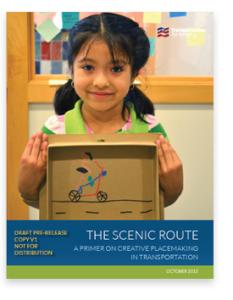
Author: Evenhouse, Erin
Publication Year:
Media Type: Report
Summary:
This report is for peope planning, designing and building transportation projects and provides an primer to creative placemaking, an emerging approach that every community should consider.
Abstract:
Late in the 20th century, the urban sociologist W. V. Walter lamented that, “For the first time in human history, people are systematically building meaningless places.” As he saw it, the problem was that the building of our cities, towns and suburbs had become the province of “experts” focused on engineered solutions to problems as they defined them, with too little interaction with affected communities. But he saw reason for hope:
Today, everyone yearns for renewal; but from a holistic perspective, what does the renewal of a city mean? It is not merely physical reconstruction, as many people think – demolishing slums and replacing them with new buildings. Historically, the renewal of a city was experienced as a mental and emotional transformation, an improvement of the spirit, a rebirth of psychic energies. (Walter, Placeways, pp. 2, 3)
The transportation field certainly had its role in the building of “meaningless places” in the modern era. The twin policies of urban renewal and freeway construction dealt a deadly blow to the quality of life in many cities during the mid-20th century.
My own city of Saint Paul, Minnesota, provided a tragic case study. Alan Altshuler’s 1966 classic study, The City Planning Process: A Political Analysis, documents the decimation of Rondo, Saint Paul’s once-thriving African American neighborhood by the routing of Interstate 94 in ways that disrupted a rich social fabric.
But as Walter suggests, recent decades have witnessed a growing sophistication and sensitivity to community on the part of those who plan transportation and land use. The interdisciplinary approach to placemaking has served as a focal point for the kinds of improvements that Walter was envisioning, giving thoughtful attention to integrating multimodal transportation with patterns of development and public spaces intended to support “mental and emotional transformation.”
While the practice of placemaking has already yielded good results in our nation’s cities, the more recent field of “creative placemaking” promises even better results. By bringing community-based arts and cultural activities into transportation and land use processes, our cities can begin not just to prepare for a better future, but perhaps to heal the wounds remaining from earlier planning errors. I’m proud that my own region is helping to lead the way in this new field, enabling us to repair at least some of the damage we inflicted upon ourselves 50 years ago. And I’m thrilled that Transportation for America has created a resource to help us all become even better creative place makers in years to come. [Foreward by Mark VanderSchaaf]
Arts & Intersections:
Categories: Transportation & Infrastructure, Public Art, Community Development
ADDITIONAL BIBLIOGRAPHICAL INFORMATION
PUBLISHER INFORMATION
Name: Transportation for America
Website URL: http://t4america.org/